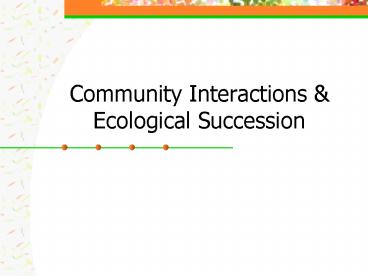Community Interactions - PowerPoint PPT Presentation
1 / 8
Title:
Community Interactions
Description:
3 main types of Symbiotic Relationships. 1) Mutualism both species ... sugary fluid secreted by. the aphids. Commmunity Interactions. Types of Symbiosis: ... – PowerPoint PPT presentation
Number of Views:451
Avg rating:3.0/5.0
Title: Community Interactions
1
Community Interactions Ecological Succession
2
Community Interactions
- SYMBIOSIS any relationship where 2 species live
closely together - 3 main types of Symbiotic Relationships
- 1) Mutualism both species benefit from the
relationship (, ) - In this picture, the aphids
- benefit as the ants protect
- them the ants benefit
- because they feed on the
- sugary fluid secreted by
- the aphids.
3
Commmunity Interactions
- Types of Symbiosis
- 2) Commensalism one organism benefits the
other remains unaffected.(, ?) - This clownfish can survive the sea
anemones stings, so the fish can benefit
from having a home while the sea anemone is
unaffected by its inhabitants. - Remember Nemo, look once, look twiceand
look several more timesbecause the ocean is
a DANGEROUS place to be!
4
Community Interactions
- Types of Symbiosis
- 3) Parasitism one organism benefits the other
is harmed (, -) - A jar of tapeworms,
- types of flatworms
- that must live in
- another organisms
- digestive tract for
- survival. They can
- grow up to 20 meters!
5
Community Interactions
- Competition results when organisms attempt to
use ecological resources (i.e. water, food,
light, space) in the same place at the same time - NO 2 SPECIES CAN OCCUPY THE SAME NICHE DUE TO
COMPETITION (this is called the Competitive
Exclusion Principle.
6
Community Interactions
- Predation when one organism feeds on another
(,-) - Predator-Prey Relationships
Population Density ( organisms)
Time (years)
7
Ecological Succession
- Succession The continual maturing of a
particular habitat through predictable changes
over time - Primary Successionwhen succession begins from an
area where no soil exists - In Primary Succession, the first species to grow
(usually lichens) is called the pioneer
species. - Example land naturally developing after a
glacier
8
Ecological Succession
- Secondary Succession when
- succession must start over after some
- sort of disturbance (the community does
- not lose its soil)
- Example land naturally developing after a
- forest fire OR farmland after agriculture is
- abandoned
- The final stage in succession is called
- a climax community, the most stable,
- diversified, and complex stage.
- (usually has many hardwood trees)

